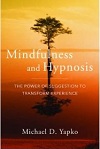The Power of Suggestion to Transform Experience By M. Yapko (2011) – W.W Norton and Co. (New York and London)
Michael D. Yapko’s most recent book, is a treasure chest of inspiration and a must read for every aspiring Cognitive Behavioural Hypnotherapist. Here, Yapko has lighted on the recent interest in the ancient Buddhist meditation of Mindfulness, which has been shown to be so successful in the treatment of recurrent depression and related anxiety problems.
In his usual style he goes straight to the point and explains his rationale simply and clearly, without obfuscating and without over reaching.
He draws a distinction between the practice of meditation as an individual pursuit, seen by some as a spiritual quest, or a strategy for self-help, and the clinical use of guided mindfulness meditation, GMM, as a interpersonal approach to emotional, cognitive and behavioural change.
The simplicity of Yapko’s approach is summarised as follows, “The very first thing you learn when you study hypnosis is this: What you focus on, you amplify. If I ask you to be aware of the sensations right now in your right hand, such as its temperature, the pressure or weight of anything you might be holding, or whatever else you might become aware of related to that hand, you can focus your attention increasingly on that hand and really become aware of it, and while you do so, you have no awareness of your left foot, until I draw your attention to it.” (Page 29)
In various ways, Yapko demonstrates the benefits of focussing awareness, to the exclusion of all else, and the practise of this strategy as a way of achieving change. CBH uses hypnosis for a variety of purposes from assessment to belief change, and so we are well used to focussing the awareness of our clients in this way. But Yapko uses this phenomenon to achieve an elegant approach to treatment.
“If you know the phrase, ‘he only sees what he wants to see,’ then you are already aware that people can notice what they choose to notice. By implication, we can also not notice what we choose not to notice. This perceptual phenomenon is referred to as selective attention, that is, the ability to focus on one portion of an experience while turning out the rest.” (Page 125)
By helping clients to recognise that they are paying selective attention to the events on their lives, past, present and future, we can help them to expand their awareness of those things that they habitually ignore or ‘turn out’, thereby restoring a balance, and improving emotional health.
There is much here to inspire, and a wealth of practical material for those already practicing and for those just starting out.
Ian Martin, Dec, 2011.


Leave a comment